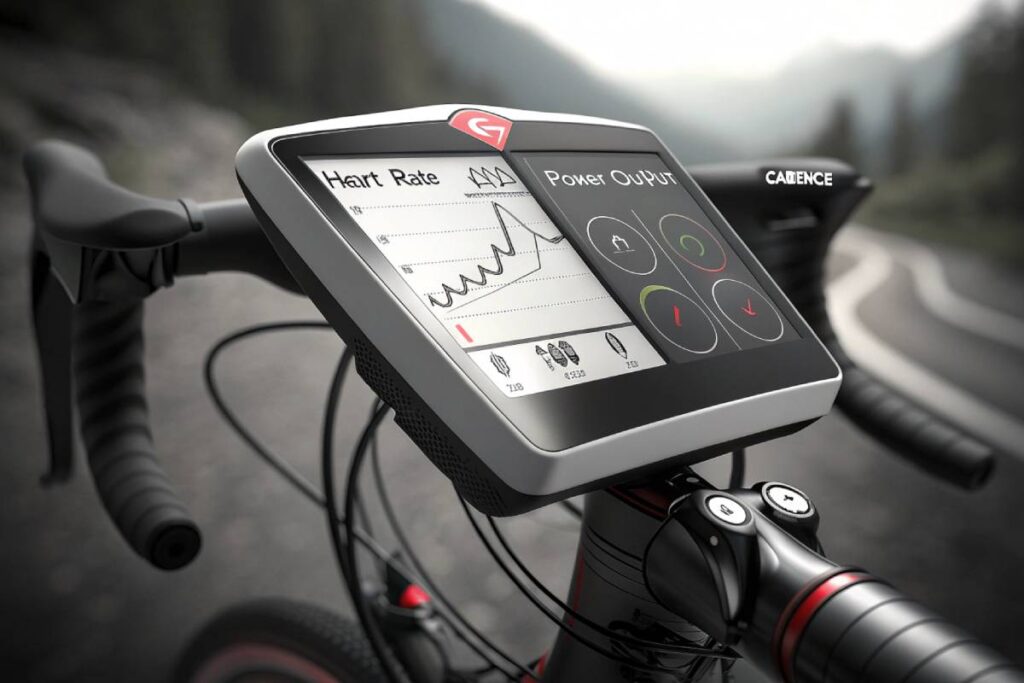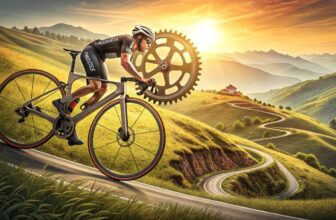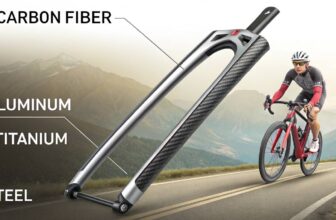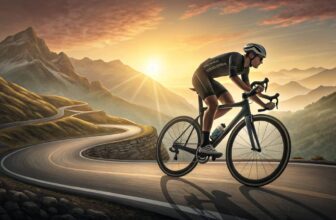Imagine hitting the open road with every metric of your ride at your fingertips, turning every pedal stroke into data-driven progress.
Whether you’re a novice cyclist finding your rhythm or a seasoned rider chasing personal bests, the right road cycling computer can transform your biking experience.
Dive into our comprehensive guide to discover the essential gadgets that keep you on track, enhance your performance, and make every journey smoother and more enjoyable.
Choosing the Right Cycling Computer
Picking the right gadget for your bike rides can make a world of difference. It’s smart to know what first-time riders need versus seasoned fitness lovers to choose wisely.

Considerations for First-time Riders
Folks new to road cycling have different demands than the pros. Simplicity and ease are the biggies when choosing a bike computer.
- User-Friendly Interface: For the newbies, easy-peasy screens are key. Wahoo bike computers are famous for being simple and straight-shooting—perfect for newcomers.
- Basic Metrics: The must-haves like speed, distance, and time should pop up easily. A solo cycling computer with these features beats juggling a smartphone (Outdoor Gear Lab).
- Cost Considerations: Look for beginner models from known brands that pack a punch for the price. Budget picks that deliver the goods without breaking the bank can be found in our section on the best cheap road bikes.
Check out this handy comparison of basic cycling computer features:
| Feature | Garmin Edge 130 | Wahoo ELEMNT Bolt |
|---|---|---|
| Speed | ✔️ | ✔️ |
| Distance | ✔️ | ✔️ |
| Time | ✔️ | ✔️ |
| Ease of Use | Moderate | Easy |
| Price Range | $ | $ |
Factors for Fitness Enthusiasts
Fitness buffs, like racers and triathletes, need next-level features from their bike computers to pump up their performance.
- Advanced Metrics: Keeping tabs on heart rate, power, and cadence is a must. Garmin and Wahoo have models with exact performance tracking.
- GPS and Navigation: If you’re mapping fresh trails, built-in GPS and turn-by-turn advice are golden. Garmin’s top-tier versions smash it with detailed maps and rock-solid guidance (Bicycling).
- Data Integration: Link up with apps like Strava for performance crunching and race tracking is gold for serious cyclists. Garmin models often blow it out of the water with tons of data capturing and syncing.
Here’s a quick overview for the gearheads:
| Feature | Garmin Edge 1030 | Wahoo ELEMNT Roam |
|---|---|---|
| Heart Rate Monitor | ✔️ | ✔️ |
| Power Measurement | ✔️ | ✔️ |
| GPS Navigation | ✔️ | ✔️ |
| Turn-by-Turn | ✔️ | ✔️ |
| Data Syncing | Extensive | Reliable |
| Price Range | $$ | $ |
A bike computer that’s just right lets cyclists get to the riding without fussing over setups. Whether you’re just starting or you’re a fitness whiz, finding the right tool makes sticking to your goals way easier. For cycling tips and tricks, cruise through our takes on road cycling techniques and the cycling power meter guide.

“A cycling computer is like a co-pilot on your ride. It provides the essential data you need without overwhelming you, making every journey more informed and enjoyable.”
— Alex Morgan, Professional Cyclist
Popular Cycling Computer Brands
Picking the right cycling computer is like finding the perfect riding buddy—it can make or break your journey. Two big names in the game are Garmin and Wahoo. Each brings something different to the table, catering to various biking needs. Let’s see what these folks are all about.
Garmin’s Leading Technology
Garmin isn’t just any tech brand—they’re the big guns when it comes to cycling bells and whistles. Their range of cycling computers is as fancy as they come, with touchscreen goodness and interfaces that feel just like your smartphone’s. It’s like having a mini supercomputer on your handlebars.
Take the Garmin Edge 540, for instance. It’s got this nifty multi-band GNSS tech for spot-on positioning plus that handy USB-C charging we all adore. And if you’re one of those who forgets to charge stuff, no worries—it’s got a battery that hangs in there for 26 hours straight, perfect for those no-stop kind of adventures.
| Model | Go Time (hours) | Key Perk |
|---|---|---|
| Garmin Edge 540 | 26 | Multi-band GNSS |
| Garmin Edge 1030 Plus | 24 | Touch Screen |
| Garmin Edge 830 | 20 | Dynamic Performance Monitoring |
Courtesy of Cyclingnews.
For those who dig deep into stats and performance analysis, Garmin is like the data nerd of the cycling world. These babies offer everything from performance analysis to epic navigation tools. If you’re a map lover or crave all the details, Garmin’s your ride-or-die. And if you want even more insights, slap on a heart rate monitor—deets on that over at Enhanced Data Tracking.
Wahoo’s User-friendly Options
Then we got Wahoo—kind of like Garmin’s laid-back cousin. They’re all about keeping things chill and easy. The Wahoo ELEMNT series is the answer for folks who want it simple without too many frills.
Wahoo setups are so smooth even a tech newbie could handle them. They’re perfect for first-timers and those who just want to keep it straightforward. Think reliable GPS, easy navigation, and third-party app integration with zero fuss.
| Model | Go Time (hours) | Key Perk |
|---|---|---|
| Wahoo ELEMNT Bolt | 15 | Aerodynamic Design |
| Wahoo ELEMNT Roam | 17 | Smart Navigation On-Device |
| Wahoo ELEMNT Mini | 12 | Compact and Lightweight |
Courtesy of Women Who Cycle.
The magic really happens with Wahoo’s pairing process—linking it up with your smartphone is a breeze. That means cruising with your ride data and map plans all synced up. For more on making this tech work for you, head over to User-friendly Setup and Integration.
So, Garmin or Wahoo? Depends on whether you love high-tech with all the extras or prefer the no-fuss, easy setup. Beginners and pros alike can find their match with both brands, turning each ride into a mini-adventure. For more on picking the right gear, peek at our guide on road bike tools list.
Advanced Features to Look For
GPS Accuracy and Stability
Getting lost isn’t fun, especially when you’re on your bike with the wind in your hair and a song in your heart. GPS accuracy is your trusty sidekick on such adventures. It’s like having a really good map but cooler and with fewer folds. Those modern cycling computers? They’re using fancy dual- and multi-band GNSS stuff to keep your GPS game strong, even if you’re playing hide and seek in a forest or cruising between skyscrapers.
Take Garmin’s Edge series, like the Edge 540 and Edge 1040 Solar—they’re basically the Sherlock Holmes of the cycling computer world, unerringly leading you through remote pathways without a hitch. Then there’s the Wahoo Elemnt Roam (v2), also getting a solid thumbs up from riders for its dual-band GPS magic. Perfect for road races or exploring new lands and rough trails.
Battery Life and Power Saving Modes
Do you know how your phone dies just as you hit the best part of your ride soundtrack? Yeah, that’s not cool for a cycling computer either. A dependable gadget should keep up with you, lasting at least 12 hours per charge so it doesn’t tap out before you do.
Garmin’s Edge 1040 Solar is like the camel of the cycling world, with a hearty 45-hour life, stretchable up to 180 hours if you’re in power-saving ninja mode. Perfect for those long-distance shindigs or if you’re just on a marathon ride because, who needs sleep anyway?
| Cycling Computer Model | Battery Life (Standard) | Battery Life (Power Saving) |
|---|---|---|
| Garmin Edge 1040 Solar | 45 hours | 180 hours |
| Garmin Edge 540 | 26 hours | N/A |
| Wahoo Elemnt Roam (v2) | 17 hours | N/A |
Keep in mind that screen brightness and notifications are like that one friend who always invites more friends to the party, consuming more battery. Keep these chatty features low-key to extend the device’s life during epic cycling adventures.
Integration and Additional Features
Extra bells and whistles on your cycling computer can really bring the party to your handlebars. The Wahoo Elemnt Roam cozies up really nicely with your smartphone, making data transfers feel as uncomplicated as Sunday mornings. Garmin likes to get social, too, automatically uploading your epic journeys onto Strava for those performance tracking bragging rights.
When shopping around for a cycling computer, think GPS finesse and marathon battery stamina. These features are game-changers, whether you’re a newbie cyclist triple-checking your route or a gritty endurance warrior planning your next epic adventure.
Make sure whatever gadget you pick can keep you on track and juiced up. After all, you never want your technology to give up before you do!
“Advanced metrics are crucial for serious cyclists aiming to optimize their performance. A reliable cycling computer with comprehensive tracking can make all the difference in training and racing.”
— Jamie Lee, Cycling Coach
Navigation Features
Cycling computers have completely changed how folks on bikes find their way around, catering to everyone from newbies to seasoned pros. Today’s bike gadgets come packed with nifty navigation features that seriously up the cycling game.
Turn-by-Turn Directions
A must-have for road cycling computers is the turn-by-turn directions. Much like those handy car GPS systems, these let riders type in a destination and get timely advice about where to head next.
- Super Simple: These directions take the head-scratching out of unknown routes, so cyclists can keep moving without constantly pausing to consult a map.
- Route Choices: Many bike computers offer a smorgasbord of base maps, with the fanciest ones delivering top-notch details. These maps are essential for riders aiming for precise and accurate info.
| Cycling Computer Model | Turn-by-Turn Directions | Quality of Basemaps |
|---|---|---|
| Garmin Edge 1030 | Yes | High |
| Wahoo ELEMNT Roam | Yes | Medium |
| Sigma ROX 12.0 | Yes | Medium |
REI Expert Advice points out the best bike computers come with navigation perks like the route back, guaranteeing riders aren’t stranded (REI Expert Advice). For more juicy details on metrics, hop over to our piece on cycling power meter guide.
Syncing with Mapping Services
Another cool trick of high-quality cycling computers is syncing up with different mapping services, making planning and adjusting rides a breeze.
- GPS Connection: Some devices can latch onto GPS even in spots without mobile service, making sure you’re always on the right path.
- Mapping Buddies: Popular picks include Ride with GPS, Komoot, and Strava. These guys offer detailed planning, tracking, and updates from fellow cyclists.
| Mapping Service | Features |
|---|---|
| Ride with GPS | Route planning, turn-by-turn directions |
| Komoot | Turn-by-turn directions, off-road maps |
| Strava | Performance tracking, community updates |
Syncing up lets riders dive into oceans of trails and user stories, tweaking their treks for new places or goals. For mountain buffs, apps like Trailforks dish out extras like jumps and air time.
Also, smartphones paired with apps like Strava or Ride with GPS work as great budget-friendly options before laying cash on a heavy-duty GPS bike gadget. Don’t miss our road cycling apps guide for more on mixing tech and biking magic.
If you’re keen on digging into advanced navigating and tracking power, our road cycling techniques article will give you even more cool stuff to chew on.
Enhanced Data Tracking
Linking Sensors for Performance Metrics
Once just simple speedometers, road cycling computers now track key performance numbers thanks to some nifty sensors. Hooked up to these devices, riders can get a grip on core metrics that help make their training sessions top-notch.
Brands like Garmin and Wahoo show off how many sensors you can hook up via Bluetooth or ANT+ (according to Women Who Cycle). You can connect things like:
- Speed sensors
- Cadence sensors
- Power meters
- Heart rate monitors
Getting all these sensors to work together means cyclists get a wealth of insight, such as:
| Metric | Sensor Required |
|---|---|
| Speed | Speed sensor |
| Cadence | Cadence sensor |
| Power Output | Power meter |
| Heart Rate | Heart rate monitor |
Once racers and fitness folks get their hands on this data, it’s game-on to tweak performance and hit those personal bests. Dive deeper into perfecting your ride by checking out our piece on road cycling cadence.
Heart Rate Monitoring Functionality
Keeping tabs on your heart rate isn’t just for gym rats—it’s gold for cyclists too, whether you’re just learning the ropes or racing to win. The ability of bike computers to monitor heart rate brings them into the league of high-end fitness buddies.
To get this setup running, cyclists need to pair their bike computer with a heart rate sensor, whether it’s a chest strap or a wrist monitor. Once synced, your bike computer gives you the real-time workout scoop.
| Cycling Computer Models | HRM Compatibility |
|---|---|
| Garmin Edge 1030 | Chest strap, wrist-based |
| Wahoo ELEMNT BOLT | Chest strap, wrist-based |
| Lezyne Models | Chest strap, wrist-based |
Heart rate tracking is like having a coach on your handlebars, helping you keep tabs on how hard you’re pushing yourself and when to back off. Discover more on this by hopping over to our road cycling training plan page.
With these fancy tracking features, road cycling computers are now vital companions for those serious about upping their cycling prowess. By bringing sensors into the mix and keeping an eye on heart rate, you’ve got the tools to dive into your riding stats and craft the path to success. And if you’re curious about cycling computer tech, check our guide on cycling power meters.
User-friendly Setup and Integration
Picking a top-notch road cycling computer is all about keeping it fuss-free and making sure it pairs up smoothly with your gadgets. This helps cyclists of every skill level stay on top of their game and connected on the go.
Smartphone Connectivity
Cycling computers that talk to your phone are a hit for those who want to see their stats on the move and hook up with their mobile gear. Bluetooth-enabled devices like the Garmin Edge 1030 and Wahoo Fitness ELEMNT BOLT let riders use features like Live Track to share ride info and alerts with pals. This boost in communication and safety is a win.
The best part of phone connectivity is syncing up with cycling apps like Strava and Garmin Connect. These apps give a deep dive into ride details, perfect for anyone from casual cruisers to serious riders.
| Model | Bluetooth | App Integration | Live Track |
|---|---|---|---|
| Garmin Edge 1030 | Yes | Garmin Connect, Strava | Yes |
| Wahoo ELEMNT BOLT | Yes | Wahoo ELEMNT, Strava | Yes |
Riders keen to merge tech with their bikes can check out our piece on road cycling apps.
Dedicated Device Benefits
Using your phone for tracking works but isn’t perfect—battery drain, needing extra holders and risk of a crash come to mind. Dedicated cycling computers deliver better performance and don’t drain your phone’s juice.
These specialized devices are built tough for cycling, offering robust features tailored to bikers’ needs: accurate tracking, long-lasting batteries, and working with lots of extras like cadence sensors, radar systems, heart monitors, and power meters.
| Features | Smartphone | Cycling Computer |
|---|---|---|
| Battery Life | Short | Long |
| Durability | Okay | Excellent |
| Sensor Integration | Limited | Expansive |
| Cycling Data Details | Simple | Detailed |
Picking up a dedicated cycling computer enhances the riding experience, delivering accurate and dependable stats. For more tips on gearing up your bike, look at our road cycling techniques and road cycling training plan.
Understanding smartphone perks and what cycling computers bring helps cyclists choose the right gear. Whatever your biking adventure, these tools keep you centered and heading for your goals.
For a smoother ride, dive into our guides on road bike maintenance and road cycling safety.
Budget-friendly Options
Do you have a passion for pedal power but not looking to splurge on a bike computer? No worries, you can score a solid companion to track your rides without your wallet crying foul. There are budget-friendly picks for everyone, from newbies to those who’ve been pedaling forever, keeping you informed with crucial stats minus the hefty price.
Basic Cycling Computer Functions
Even the simplest bike computers, priced as low as thirty bucks, offer stats that matter—speed, average speed, distance you’ve tackled, time spent riding, and your top speed Women Who Cycle. Surprised? These smart gadgets rely on sensors slapped onto your bike’s front fork, doing their magic as a magnet whizzes by a wheel spoke.
Value for Money Considerations
Hunting for a cycling computer that gives you bang for your buck? Start by figuring out what you need in your two-wheeled sidekick. Ask your cycling crew for their wisdom, weigh in on the size and how you want it mounted, and think about battery life based on how often you’re on the road Women Who Cycle.
Guess what? Popular choices like Cateye’s Urban Wireless and Padrone models, along with Garmin’s Speed Sensor 2, are fantastic picks for around $35 Bike Shop Girl. They keep tabs on your rides, miles, and speed like a personal coach. Keep in mind though, that Garmin’s Speed Sensor 2 teams up with one bike at a time through the Garmin Connect app.
| Brand/Model | Price | Key Features |
|---|---|---|
| Cateye Urban Wireless | $35 | Speed, Distance, Time |
| Cateye Padrone | $40 | Big Display, Wireless |
| Garmin Speed Sensor 2 | $35 | Trip Tracking, Distance, Speed |
Some basic models even hook up to extra gadgets like cadence sensors, taillight radar, or heart monitors Bike Shop Girl. Not keen on packing all that in upfront? A smartphone paired with cycling apps like Strava or Ride with GPS can do the trick.
These babies bring stuff like turn-by-turn navigation and heart rate tracking when teamed up with smartwatches or Bluetooth monitors. Sure, you might face a quick-draining phone battery or weather woes, but they do dish out detailed data rivaling any bike computer.
Curious for more tips on cycling gear? Get a load of our pieces on the best cheap road bikes and best road bike helmets. Need your trusty steed in top form? Our guides on road bike maintenance and road bike cleaning will help you keep it rolling smoothly.
Future Trends in Cycling Computers
Advancements in Form Factor
Cyclists nowadays want gadgets that are not just fancy but also small and easy to carry. Devices like Garmin and Wahoo are hustling to keep things tidy without pulling the plug on essential features, aiming for tech that feels part of the bike—slim and stylish.
Today’s cycling computers emphasize:
- Compactness: Fits snugly on any bike without fuss.
- Big, Bold Screens: Easy to read, whether it’s sunny or cloudy.
- Featherlight: Keeping things nimble for those long rides.
| Feature | Improvement |
|---|---|
| Size | Trimmed down for sleek mounting |
| Display | Sharp visuals for all light conditions |
| Weight | Under 100g for that airy feel |
Making these gadgets more nifty appeals to everyone—from folks trying their first ride to those serious about fitness.
Integration with Electric Bikes
E-bikes are all the rage, and bike computers are joining in on the fun. There’s a growing buzz for models that talk to your e-bike like an old buddy. Leading brands like Bosch are merging seamlessly with smart dashboards that track your ride and much more.
Imagine having:
- Battery Feedback: Know exactly how much juice you’ve got left for the ride.
- Performance Stats: Syncing with your bike for detailed insights.
- Travel Guidance: Navigation just for e-bikes to keep you on track.
| Feature | Integration |
|---|---|
| Battery Monitoring | In-the-moment battery updates |
| Performance Metrics | Detailed motor insights |
| Navigation | E-bike friendly route guidance |
On top of these, there’s the promise of:
- Power Saver: Stretch your battery life smartly.
- Phone Hook-Up: Share routes and get live updates right on your phone.
Whether you’re new to e-bikes or a seasoned rider, opting for a cycling computer that vibes with e-bike tech pays off. From knowing your bike’s gears to keeping it in tip-top shape, the right tech can really up your riding game.
Cycling tech’s making strides, blending fun with data for smoother rides, whatever your jam—from chilling out on weekend tours to chasing racing dreams. Here’s to the future of cycling with friendly, connected gizmos that get you and your bike working together like never before!
Conclusion
Choosing the perfect road cycling computer is more than just selecting a gadget—it’s about enhancing your entire riding experience.
From user-friendly models ideal for beginners to feature-packed devices for fitness enthusiasts, there’s a cycling computer tailored to every cyclist’s needs.
Brands like Garmin and Wahoo stand out by offering reliable performance, advanced metrics, and seamless integration with your favorite apps. By investing in the right technology, you’ll not only track your progress but also stay motivated and connected on every ride.
Gear up with the essentials we’ve recommended and ride confidently into a future where every journey is optimized for success.
Frequently Asked Questions (FAQs)
Q1: What features should beginners look for in a road cycling computer?
Beginners should prioritize simplicity, ease of use, and essential metrics like speed, distance, and time. User-friendly interfaces and reliable battery life are also important.
Can road cycling computers sync with fitness apps like Strava?
Yes, many road cycling computers, especially from brands like Garmin and Wahoo, offer seamless integration with fitness apps like Strava for performance tracking and data analysis.
How long does the battery typically last on a high-end cycling computer?
High-end cycling computers like the Garmin Edge 1040 Solar can last up to 45 hours on a single charge, with power-saving modes extending battery life further.
Are cycling computers waterproof?
Most cycling computers are designed to withstand various weather conditions and are water-resistant, but it’s always best to check the specific model’s water rating.
Do I need additional sensors for advanced metrics on my cycling computer?
Yes, for advanced metrics like heart rate, power output, and cadence, additional sensors such as heart rate monitors, power meters, and cadence sensors are required.




